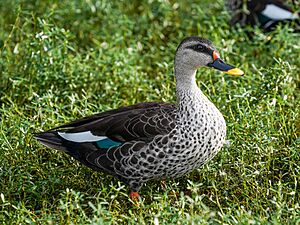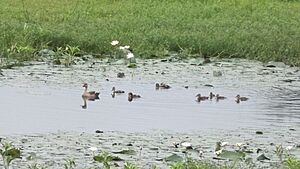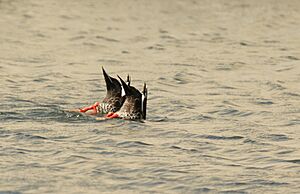Indian spot-billed duck facts for kids
Quick facts for kids Indian spot-billed duck |
|
|---|---|
 |
|
| Indian spot-billed duck (A. poecilorhyncha) |
|
| Conservation status | |
| Scientific classification | |
| Genus: |
Anas
|
| Species: |
poecilorhyncha
|
| Subspecies | |
|
|
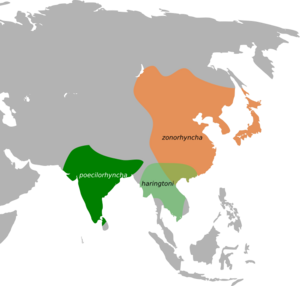 |
|
| Approximate breeding ranges (green) | |
| Synonyms | |
|
Anas poikilorhynchus |
|
The Indian spot-billed duck (Anas poecilorhyncha) is a large type of dabbling duck. These ducks live in freshwater areas like lakes and marshes in the Indian subcontinent. They don't usually migrate, meaning they stay in the same area all year. You can spot them by a red mark at the base of their bill. When they're in the water, look for a white stripe on their side, which comes from special feathers called tertials. In flight, they have a green patch on their wings, called a speculum, with a wide white band. This duck and the eastern spot-billed duck were once thought to be the same species.
Contents
About the Name
The Indian spot-billed duck was first described by a scientist named Johann Reinhold Forster in 1781. He gave it the scientific name Anas poecilorhyncha. The word Anas is Latin for "duck." The second part, poecilorhyncha, comes from ancient Greek words meaning "spotted" and "bill." This name perfectly describes the duck's spotted bill.
Scientists recognize two main types, or subspecies, of the Indian spot-billed duck:
- A. p. poecilorhyncha: This type is found in India and Sri Lanka.
- A. p. haringtoni: This type lives from Myanmar to southern China and Laos. It was named after Herbert Hastings Harington.
The eastern spot-billed duck used to be considered a third subspecies. However, scientists noticed that even when both types lived in the same area, they rarely had babies together. Because of this, most scientists now consider the eastern spot-billed duck a completely separate species.
What They Look Like
This duck is about the same size as a mallard duck. It has a body that looks scaly and a green speculum (a patch of colored feathers on its wing) bordered by white. When the duck is resting, the white stripe on its side really stands out. Its long neck and bill, which has a yellow tip and orange-red spots at the base, are also easy to spot. The red spots on the bill are not found in the haringtoni subspecies.
Indian spot-billed ducks are usually grey with a lighter head and neck. Their bill is black with a bright yellow tip. They are about 55 to 63 centimeters (22 to 25 inches) long. Their wingspan is about 83 to 95 centimeters (33 to 37 inches). They weigh between 790 and 1500 grams (1.7 to 3.3 pounds).
The male duck has a clear red spot at the base of its bill. This spot is either missing or very hard to see on the female, who is also a bit smaller. The male duck's feathers don't change much during the year. Their legs and feet are bright orange or coral red. Young ducks are browner and not as bright as the adults. Both male and female ducks lose all their wing feathers at once after breeding.
Where They Live
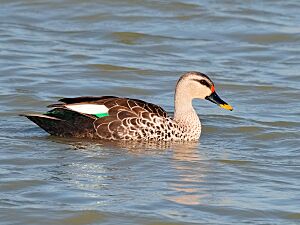
These ducks live all year round in Pakistan and India. They prefer freshwater wetlands, which are areas with water and lots of plants. They usually avoid very large open water areas. Sometimes, a few ducks might travel long distances. For example, one duck tagged in India was found in Russia!
Indian spot-billed ducks often stay in small groups when it's not breeding season. They have also been seen moving further north over the years. This might be because of global warming.
Life and Habits
Indian spot-billed ducks live in freshwater lakes and marshes in open areas. They mostly eat plants by "dabbling," which means they dip their heads into the water to find food. They usually feed in the evening or at night.
Reproduction and Life Cycle
The breeding season for these ducks depends on rainfall and water conditions. In northern India, it's usually from July to September. In southern India, it's from November to December. They can have more than one group of babies in a year.
They build their nests on the ground, hidden in plants near water. A female duck lays 8 to 14 eggs. Sometimes, nests have even been found on tree branches covered by climbing plants. The mother duck starts sitting on the eggs after the last one is laid. This makes sure all the ducklings hatch at the same time, which takes about 24 days. The baby ducklings are black with a yellow back. They look a bit like baby mallards but have a wider stripe around their eyes.
Both male and female ducks make sounds similar to a mallard duck. Indian spot-billed ducks eat plants, including crops like rice. They also eat small creatures without backbones, such as snails.
These ducks are often seen by themselves or in small groups. When something bothers them, they can take off from the water very quickly, almost straight up into the air. They were once hunted a lot. If they are shot at, especially when they are losing their feathers, they are known to dive underwater to hide. Natural enemies of these ducks include birds of prey (like eagles) and animals on land, such as pythons and otters.




